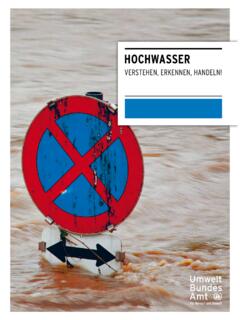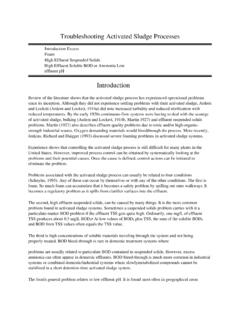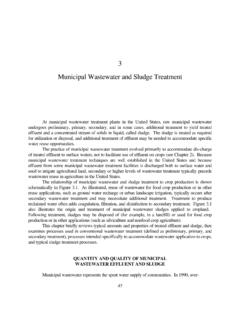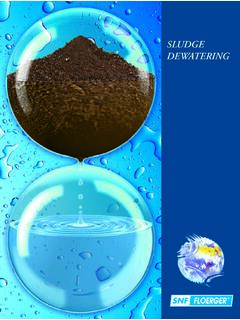Transcription of Sewage sludge management in Germany - Umweltbundesamt
1 In GermanySewage sludge managementOrder brochures address: Umweltbundesamt c/o GVPP ostfach 30 03 61 | 53183 Bonn | GermanyThe brochure is service: +49 (0)3 40 21 03-66 88 Fax service: +49 (0)3 40 21 04-66 88 Benjamin Claudia DienemannDr. Christian KabbeM. Sc. Simone BrandtDr. Ines VogelDr. Andrea RoskoschPublisher: Umweltbundesamt (UBA) | Postfach 1406 | 06844 Dessau-Ro lau | Germanyin GermanySewage sludge managementContentsPreface31 Introduction4 What is Sewage sludge ?4 Where does Sewage sludge occur?
2 52 Composition of Sewage sludge7 Heavy metals in Sewage sludge9 Organic compounds in Sewage sludge11 Pathogens and health hazards arising from EHEC12 Pharmaceutical drug residues in Sewage sludge143 sludge treatment164 Thermal sludge treatment23 Mono-incineration23Co-incineration255 Sewage sludge use in the agricultural sector29 Nutrients in Sewage sludge30 Sewage sludge pollutants31 Pros and cons of using Sewage sludge as a fertilizer346 Phosphorous recovery34 Phosphorous recovery potential and processes 36 Cost efficient phosphorous recycling in Germany387 Sewage sludge quantities.
3 management and recycling428 Footing the bill for Sewage sludge management509 The way forward5210 Illustrations5811 Tabels5812 Abbreviations6013 Acknowledgements6214 Bibliography6215 Appendix I6816 Appendix II82 Sewage sludge management legislation8217 Appendix III87 Heavy metals in Sewage sludge8718 Appendix IV882 ContentsPrefaceGermany s municipal Sewage treatment plants generate some two million tons of dry Sewage sludge annually, with the proportion of ther-mally treated Sewage sludge increasing from per cent in 2004 to more than 54 % in 2011.
4 sludge , which is usually incinerated or used as agricultural fertilizer, contains a whole series of harmful substances that complicate the task of sludge management . But sludge also contains a number of nutrients such as phosphorus, nitrogen and potassium. Hence the goal of Sewage sludge management is to remove sludge pollutants while retaining sludge nutrients. Sewage sludge undergoes thermal recycling at facilities such as Sewage sludge mono-incineration plants, cement plants and coal fired power plants. Sewage sludge utilization for farming pur-poses has plateaued of late (2006 to 2011) at around 29 %, an evolution attributable to more stringent quality standards for Sewage sludge .
5 However, Sewage sludge is set to take on grea-ter importance as a raw material, mainly due to the increased concentrations of phospho-rous it contains. This pamphlet discusses the potential offered by Sewage sludge and the ways it can be used sustainably. The pamphlet also describes the current status of Sewage sludge management in Germany , with particular emphasis on the extent to which sludge use as a fertilizer can be reduced without foregoing phosphorous and other sludge nutrients. Over the next one to two decades, Germany needs to wean itself away from using Sewage sludge for farming and at the same time efficiently leveraging the potential for using Sewage sludge as a low cost is Sewage sludge ?
6 In Germany , daily water use now reaches 120 litres per person. All of this water ulti-mately ends up in the Sewage system, and from there is channelled to Sewage treatment plants. At such plants, the Sewage passes through screens and sieves and undergoes mechanical and biological purification, the goal being to remove impurities from the Sewage and to then channel the re-sulting purified water into waterbodies. The residue of this process is known as Sewage sludge , which can occur in anhy-drous, dried or other processed forms.
7 Raw sludge is Sewage sludge that is remo-ved from Sewage treatment plants without being treated. Sewage sludge is generated by both municipal and industrial Sewage treatment plants. When it comes to material recycling within the meaning of the Sewage sludge Ordinance (Kl rschlammverordnung, AbfKl rV), only Sewage sludge from mu-nicipal Sewage treatment plants is usually suitable. Under the said ordinance, Sewage sludge compost and mixtures also qualify as Sewage sludge . Sewage sludge mixtures are mixtures of Sewage sludge and other conformant substances, in accordance with Appendix 2 tables 11 and 12 of the Fertilizer Ordinance (D ngemittelverordnung, D MV).
8 Sewage sludge compost comprises compos-ted Sewage sludge mixtures [ABFKL RV]. Sewage sludge can be characterized based on various physical, chemical and micro-biological parameters, using the characte-ristic values listed in table 1. It should also be noted that apart from these parameters, there are others such as the sludge volu-me index and digestion time that are also used to characterize Sewage sludge . For example, elevated loss on ignition indicates a high organic substance con-centration in Sewage sludge .
9 One of the purposes of Sewage sludge incineration is to expunge the organic substances from the sludge . Hence loss on ignition is one of the key parameters when it comes to characteri-zing Sewage sludge combustibility, whereby water content is also an important factor, since unduly high water content reduces the calorific value of fuel. And finally, Sewage sludge should never be characterized on the basis of only a single parameter, because the parameters are always IntroductionTable 1: sludge parameters and their significance [Kopp; R biger]Parameter Unit of measure ExplanationDry solids (DS)e.
10 G. kg, g, mgThe drying process results in a dry-mass/-solids residue in dry sludge . Determined by subtracting water content. Total solids (TS) e. g. kg/m3, g/lThe dry mass content in a given residue (DR)%Unit of measure for the solid content of a non-filtrated sludge sample; dry mass portion of given volume of sludge . Determi-ned by vapourizing water content. Water content (WC)%Unit of measure for the water content of a given volume of sludge . Determined via vapourizing water content. Residue on ignition (ROI)%Unit of measure for the inorganic or mineral content of dry solids in Sewage sludge .


















